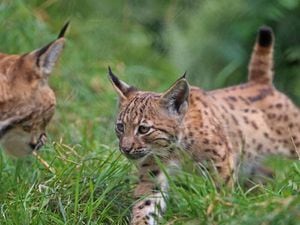Everything you need to know about the move to reintroduce lynx to the British countryside
The Lynx UK Trust has submitted an application to Natural England for a trial.

After being absent for more than 1,300 years, lynx could make a comeback – if the plans to reintroduce them to the British countryside are approved.
The Lynx UK Trust has submitted an application to Natural England to carry out a trial reintroduction of six Eurasian lynx in the Kielder Forest region of Northumberland.
It is the first time an application has ever been made in the UK for this species but the move has left people divided, with some experts saying the presence of wild cats could keep the roe deer population under control while farmers and many others believe it could have a significant impact on livestock numbers.
Here’s everything you need to know.
What are lynx and are they dangerous to humans?

Lynx UK says: “Tens of thousands of wild lynx in all kinds of places have failed to lay a single claw on the smallest child; that they have the ability to hurt us is irrelevant; no wild lynx has ever chosen to, and that should give us confidence to give them a chance to live alongside us again.”
They became extinct in the UK more than 1,300 years ago and are believed to have been hunted for their fur.
So what will happen if the permission for a lynx trial is granted?
If permission is given, four females and two males will be reintroduced in the Kielder Forest region for a five-year period, wearing GPS collars to monitor their movements.
The cats will come from healthy wild populations in Europe, will be subject to full veterinary screening, and information gathered from the trials will be used to decide whether a full reintroduction can be carried out.
The chief scientific adviser on the project, Dr Paul O’Donoghue, said: “Tens of thousands of man hours of work by a huge team of people have gone into consultations shaping this final application which marks a significant milestone in the history of UK conservation – potentially the first return of an extinct predator, which could prove to be a really keystone species for our ecosystem.”
So how would this affect the woodland’s ecosystem?

A study published in 2015 in the Journal of Wildlife Management found that the roe deer population in the UK to be at its highest – at around 1.5 million.
The researchers from the University of East Anglia who conducted the study believe that this over-population has affected the woodland vegetation (which serves as food for the deer) and is posing a problem for migrant bird species like blackcaps and nightingales and resident species like the willow tit.
But Dr Christopher Sandom, a biology lecturer at the University of Sussex with expertise in ecological processes such as predation, believes it is difficult to predict the end result but adds, if successful, the trial could lead to positive outcome.
“Predicting what will happen when you reintroduce an animal is very very difficult and depends on the individual animal you introduce as well as the landscape and the ecosystem to which you are reintroducing them,” he said.
“If we find the lynx did have an impact on the deer population, it could change the local vegetation which could have big biodiversity benefits.”
Why is the local farming community unhappy about it?

He added: “In my mind if lynx were to be released in Kielder, the opinions of people living and earning from that area should carry far greater weight than those of someone living 300 miles away. It is the local people that are the real stakeholders.”
Claire Robinson, countryside adviser for the National Farmers’ Union (NFU), says that the reintroduction of species – particularly if it hasn’t been in this country for hundreds of years – could drastically impact the local biodiversity and no one knows what outcome this might have.
She said: “In the time since lynx last appeared in this country, the habitat around us has changed dramatically, our population has increased drastically and on top of this, we do not know how lynx would behave in the current environment.”
So would the lynx put the local sheep at risk?

Dr Sandom also agrees sheep might find themselves an easy prey to the lynx but believes that would depend on how the sheep would be farmed.
“If pastoral care is taken, you can stop the sheep from coming close to those animals but if you let the sheep run free in the habitat then they could be targeted,” he said.
But he also adds that it is difficult to predict how the animals would behave and whether a lynx would choose wild prey over sheep could very well depend on its personal preference.
How easy is it to bring an extinct animal back into the ecosystem?

She said: “The most vital part of a successful reintroduction is ensuring that previous threats have been addressed. There is only enough suitable habitat for the long-term survival of lynx in Scotland.
“Another essential ingredient for success is ensuring the local people are on side. If farmers and game keepers aren’t supportive, the survival of the species will be at risk.”
Will lynx bring economic benefits to the Kielder region?

Successful reintroductions have taken place in places like Germany, France and Switzerland and there are now more than 10,000 lynx in Europe.





